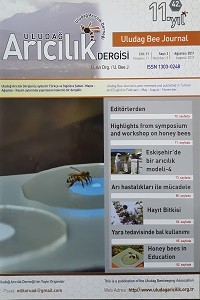Abstract
Arılar tarafından üretilen bal, çok eski zamanlardan bu yana birçok hastalığın tedavisinde kullanılmaktadır. Bal, veteriner hekimlik alanında en çok yara tedavisinde kullanılmıştır. Yara tedavisinde bal kullanılması ile yaranın iyileşmesi sağlanır ve sistemik antibiyotik kullanımına gerek kalmadan bakterileri elimine edilir. Burada balın en önemli özelliklerinden birisi antibakteriyel etkisidir. Bu etki balın pH’sı, içerdiği hidrojen peroksit, osmotik etkisi ve içeriğinde bulunan fitokimyasal ajanlardan kaynaklanmaktadır. Bal yaralardaki yangısal ödemi azaltarak yara iyileşmesine olumlu etki yapar ve yara ile ilgili komplikasyonların azalmasına yardımcı olur. Sonuç olarak hayvanlarda geniş ve enfekte yaraların tedavisinde bal kullanılması alternatif, etkili ve ekonomik bir yaklaşımdır
Keywords
References
- Abramson, C. I. 1990. Invertebrate learning: A laboratory manual and source book. Washington, D.C., American Psychological Association.
- Abramson, C. I., Buckbee, D. A., Edwards, S., Bowe, K. 1996. A demonstration of virtual reality in free-flying honey bees: Apis mellifera. Physiology & Behavior: 59, 39-43.
- Abramson, C. I., Mixson, T. A., Cakmak, I., Wells, H. 2007. The use of honey bees to teach principles of learning. Uludag Bee Journal, 7: 126-131.
- Hill, P. S. M., Hollis, J., Wells, H. 2001. Foraging decisions in nectarivores: unexpected interactions between flower constancy and energetic rewards. Animal Behaviour, 62: 729–737.
- Hill, P. S. M., Wells, P. H., Wells, H. 1997. Spontaneous flower constancy and learning in honeybees as a function of colour. Animal Behaviour, 54: 615–627.
- Sanderson, C. E., Wells, H. 2005. The flower fidelity of the honey bee. Uludag Bee Journal, 5:145-151.
- Sanderson, C. E., Orozco, B. S., Hill, P. S. M., Wells, H. 2006. Honey bee (Apis mellifera ligustica) response to differences in handling time, rewards and colors. Ethology, 112: 937–946.
- Wenner, A. M., Wells, P. H. 1990: Anatomy of a Controversy: the Question of a “Language” Among Bees, New York, Columbia University Press.
Abstract
Keywords
References
- Abramson, C. I. 1990. Invertebrate learning: A laboratory manual and source book. Washington, D.C., American Psychological Association.
- Abramson, C. I., Buckbee, D. A., Edwards, S., Bowe, K. 1996. A demonstration of virtual reality in free-flying honey bees: Apis mellifera. Physiology & Behavior: 59, 39-43.
- Abramson, C. I., Mixson, T. A., Cakmak, I., Wells, H. 2007. The use of honey bees to teach principles of learning. Uludag Bee Journal, 7: 126-131.
- Hill, P. S. M., Hollis, J., Wells, H. 2001. Foraging decisions in nectarivores: unexpected interactions between flower constancy and energetic rewards. Animal Behaviour, 62: 729–737.
- Hill, P. S. M., Wells, P. H., Wells, H. 1997. Spontaneous flower constancy and learning in honeybees as a function of colour. Animal Behaviour, 54: 615–627.
- Sanderson, C. E., Wells, H. 2005. The flower fidelity of the honey bee. Uludag Bee Journal, 5:145-151.
- Sanderson, C. E., Orozco, B. S., Hill, P. S. M., Wells, H. 2006. Honey bee (Apis mellifera ligustica) response to differences in handling time, rewards and colors. Ethology, 112: 937–946.
- Wenner, A. M., Wells, P. H. 1990: Anatomy of a Controversy: the Question of a “Language” Among Bees, New York, Columbia University Press.
Details
| Primary Language | English |
|---|---|
| Subjects | Structural Biology |
| Journal Section | Research Articles |
| Authors | |
| Publication Date | August 25, 2011 |
| Published in Issue | Year 2011 Volume: 11 Issue: 3 |
Important Note: Since the author-referee information is kept confidential on both sides in our journal, both the author and the referees must upload the document to the system after removing their personal information in the review document section.
Note: Authors can also use homepage of our Journal.
https://creativecommons.org/licenses/by-nc-nd/4.0/
This work is licensed under Attribution-NonCommercial-NoDerivatives 4.0 International.


